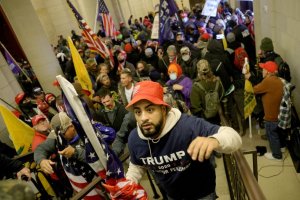US Coup d’Etat vs the FX industry: What will happen to brokers in the world’s most lucrative market?
Is America becoming China? It is quite common to be asked by a broker as to how much the Chinese IB would like to deposit to test the system. The answer, in many cases is “About $250.” This means $250 million! Here is my opinionated and open view on the western FX industry and its environment these days.

The United States has an absolute love/hate relationship with the retail electronic trading industry, and conversely, FX brokerages have a love/hate relationship with doing business in the United States.
On the face of it, although this matter is often ignored by FX brokerages outside the United States, it is the best and most lucrative country in which to operate a retail brokerage. Traders in the United States are highly analytical, often have portfolios with many retail brokerages and are au fait with listed derivatives trading via some of Chicago’s giants, have very long lifetime values, are loyal to their brokerage and have significantly larger minimum deposit sizes than any other region in the world.
In essence, would a brokerage not rather operate from within a massive nation with the most advanced economy in the world, and provide its astute population with a stable and long term method of trading the markets rather than approach ‘leads’ in third tier countries for $200 deposits by people who have no idea what capital markets are?
Pioneers such as Thomas Peterffy knew this, and continued to understand the value of a strong base in the United States until the day he retired.
Since he retired, the company which he founded back in the early 1970s, Interactive Brokers, which changed his fortunes as he rose from a penniless immigrant from Hungary to become one of the world’s most revered electronic trading executives, presiding over a publicly listed company which was so well capitalized that it had over $80 million in regulatory capital when $20 million is the requirement set forth by the National Futures Association, has not been the same at all.
Mr Peterffy, therefore, is the epitome of the American Dream.
His retirement signaled the end of the polished, blemish-free and immaculate reputation of Interactive Brokers, and the new team have only been operating the company for a short time, and have been responsible for regulatory censuring, litigation and system outages. Not the stuff of completely blot-free Mr Peterffy.
The well known adage “The first generation makes the money, the second generation blows it” is not an adage for no reason.
That applies to today’s Western government leaders too.
Back in the dark days of the 1970s when the United States was fighting communism, the Chinese Communist Party was sneaking in via the back door.
Western forces, led by some of the best leaders in history, namely Ronald Reagan, Margaret Thatcher and Mikhail Gorbachev sought to unite the world. settle differences between East and West, drive forward a change from concrete-block, hard faced, expression-free socialism to self-determining capitalism.
Growing up in the 1970s, and remembering the transition in the 1980s and how the world changed was fascinating. I witnessed the end of the Stalingrad gray era of no incentive, the endless coercion between population and government, and the move toward “Americanization” which incentivized previously morose and motivationless people toward their own destiny of financial independence, personal liberty and freedom.
The world’s colors changed from gray to pastel. Concrete gave way to plate glass. Poverty and limitation gave way to self determination and succees.
It was a wonderful time to grow up.
The United States was already a bastion of self-determined freedom, however, and its people valued it highly and respected it. We all looked up to these measured people as roles model and examples.
Today, things are somewhat different.
The menace which was entering via the back door at the same time as Mssrs Reagan, Thatcher and Gorbachev were doing their absolute best to liberate the world and give people their absolutely deserved freedom, was beginning of the Chinese attempt to install a global communist dictatorship, which is now being unleashed on the world today.
During the 1970s the Chinese Communist Party, which owns every single business via minority shareholding (and in some cases full or majority shareholding) in China had begun sending CEOs of state owned Chinese companies into the United States to gain supplier agreements to provide Chinese made components to American corporations.
They did so very cheaply, and possibly took a loss in order to gain the business, and make America reliant on a Chinese supply chain.
Four and a half decades later, China is in charge of America by proxy, and has now exported its coercive dictatorship to the once-free west.
North Western Europe, the United States, Canada and Australia are all targets for Chinese domination, and it is being carried out under the false guise of a ‘virus’, the leaders of each nation complicit in using a tool to lock their populations down, close private enterprise, remove liberties forever, and impose a police state in which permission for even inviting guests to one’s own home is required.
This is how Chinese people live. The tyranny imposed by the powerful, business-savvy government is tremendous, yet unknown to the West as it is kept very quiet and its 1.45 billion-strong population adhere to it with millimetric precision or face dire consequences.
Now, the West is following this pattern. Chinese supply chain totally owns the United States. Chinese government-owned investors own the majority of stock of FTSE100 listed companies in the UK, and Chinese investors own almost all condominiums, malls, and banks in Canada, control all import/export business in Australia, and want representation in the European Union via the disablement of France, Spain, Italy and Germany – already nations in their economic nadir.
As the people of Europe adhere to the incredible wing-clipping exercises, things in the United States are somewhat different.
President Trump, the only world leader in today’s West that actually comes from a business background and has done far more than simply go to school and then become Prime Minister, knew that this is a communist takeover, and as a result has been denied a second term, representing the first ever time in US history that any large number of people, including the President himself, have ever questioned the validity of an election result.
Socialist Mr Biden is China’s plant for the United States. He has a long history of hobnobbing with the Chinese Communist Party, and the Chinese authorities have got so much dirt on him that he will do as they tell him in order not to be hung out to dry by President Xi and his 2 million-strong army of data scientists.
Now, in the United States, the world is witnessing a possible Coup d’Etat, as this week’s unbelievable event took place in which thousands of protestors violently stormed the US Capitol building in Washington DC, resulting in gunfire, deaths, and a breach of security never seen on American soil in 245 years of constitutional history.
The extremism is now huge. The divisions are huge in a once united country. E Pluribus Unum. Out of Many, One.
Not anymore. Now it is BLM communist revolutionaries vs fundamental Confederate States-recognizing Trump supporters. It is Antifa vs Capitalism. Each ethnicity vs each other.
A nation that has turned on itself, especially after this Chinese government planned global dictatorship resulted in lockdowns that cost over 40 million freedom loving Americans their livelihoods in the spring of 2020.
In America, freedom and liberty is almost an untouchable given. Take it away, and the fires start.
Now, with a potential turn of tide toward extreme socialism, what does this mean for brokerages in the US?
There was an exodus of foreign brokers in 2011, just after the Dodd-Frank Wall Street Reform Act was sworn in by President Barack Obama, which required US based FX brokers and holders of National Futures Association licenses to only onboard US-based clients, and to have a regulatory capital adequacy of $20 million.
Indeed, it is popular opinion that many of the brokers that packed up and left had the money to put aside, but did not want to adhere to the rules which were designed to straighten out the industry and remove poor ethics.
Quite simply, many non-American firms that packed their bags did not have the mettle or business ethic to operate in the US, which was very short sighted given the tremendous opportunities to succeed in a well organized, properly regulated environment with a domestic market audience with high average first time deposits of $6400 rather than the $3800 in the rest of the world, astute trading abilities and proper infrastructure.
In the middle of the last decade, some good quality firms began to return. FinanceFeeds was the first to report that IG Group had re-established its NFA license and had opened in Chicago, its previous home in the US before it exited in 2010.
This was a tremendous opportunity for IG Group, a firm with its own platform (required in America – nobody will use MT4) and its own high quality reputation and public listing on London Stock Exchange. Since its return to the US, however, things have been quiet.
A few years ago, I advocated the return to the US by companies that could afford it. It represented the best move forward, the chance to operate in a sustainable environment of sensible investors and seasoned traders, with a regulator that properly understands our business unlike any other region, and a means of ridding brokers from the headache of dealing with low-end gamblers in far flung places who have no idea what trading is about, an end to race-to-the-bottom affiliate marketing, an end to casino-style credit card deposits and a key to a decent, high quality business environment.
With the instability that is happening now, however, who knows what may happen.
OANDA Corporation, a company which managed to survive despite years of headless leadership, cronyism and endless absurd corporate decisions, nestled alongside GAIN Capital and FXCM as a trio with unique access to this incredible market.
GAIN Capital and OANDA began fighting with each other, which is an exact representation of privileged Americans today fighting with each other instead of realizing how fortunate they are.
What is to be gained from this? Nothing apart from expending resources in the wrong direction and lawyers getting rich. In October last year, another instalment in the litigation battle between GAIN Capital and OANDA Corporation took place, this time in the form of GAIN Capital’s shoulder-shrugging gesture to opponent OANDA Corporation in relation to a rather absurd patent claim.
The basic outline of the interaction between the two companies stems from OANDA Corporation’s assertion that GAIN Capital infringed two patents that it has registered with the US Patent office, and as a result of which OANDA Corporation decided to go to court over it.
In many respects, the actual cause of this is not what companies in the retail sector that have a litany of commercial and leadership U-turns behind them should be concentrating on. Instead, perhaps moving forward and setting the tone as a good quality, technology led bastion of service and efficiency should be the focus.
OANDA Corporation is no stranger to alienating not only its rivals, but also its stakeholders through several years of headless leadership which resulted in a revolving door policy of recruiting completely unknown CEOs from unproven backgrounds who are here today, gone tomorrow, and often with a commercial disaster behind them.
The company seems to fit into two categories. One one hand, it has some of the highest quality technology in the retail industry. OANDA’s R&D center in Silicon Valley and its decade long commitment to refining the trading environment is to be very much admired, yet its leadership, until recently, was problematic to say the least.
For this reason, instead of spending millions of dollars trying to fight its only rival in its home market of the United States, and potentially getting nowhere apart from generating some bad press and concentrating resources on fighting with a competitor instead of enhancing its own service, perhaps OANDA should be taking this time to make use of its new, high quality management team and forging ahead.
GAIN Capital, despite its long standing time in the market, is unlikely to simply settle this matter and move on.
If patents have been breached, maybe the sensible way would be to make GAIN an offer, and then settle, and move on.
Patent infringement is almost impossible to prove.
A few years ago, some of the well recognized technology companies within the FX industry were blighted by fraudulent attempts to accuse them of copyright infringement by patent trolls.
Patent trolling has been less of a problem in Europe than in the U.S. because Europe has a ‘loser pays costs’ regime, however this has not stopped patent trolls approaching certain British FX technology companies and effectively ambushing them, requiring serious litigation in order to be able to put a stop to their activities.
Rather unbelievably, some companies have previously engaged in lawsuits regarding patent trolling, one of which is North American online trading platform software company ThinkorSwim, headquartered in Chicago, Illinois.
ThinkorSwim is a very long established company, owned by TD Ameritrade, and was founded by Tom Sosnoff in 1999, and according to FinanceFeeds sources, which are senior level American FX industry technology executives, ThinkorSwim is actually licensing some patent troll material in which any company with a revenue of over $10 million gets approached automatically.
ThinkorSwim provides services including thinkDesktop, webBasedTrading, thinkAnywhere, thinkMobile, thinkMicro, and paperMoney, and the ActiveTrader component of such products to provide access to exchanges in Chicago, including the Chicago Board Options Exchange (CBOE).
Five years ago, Trading Technologies sued ThinkorSwim and its owner, TD Ameritrade, alongside six other companies for infringement of patent in the Northern District of Illinois.
The case was closed in September 2015, five years after it was filed.
Trading Technologies sued ThinkorSwim for four patent infringements relating to click based trading with Intuitive Grid Display of Market Depth – Patent issued August 3, 2004, and a user interface for an Electronic Trading System – Patent issued May 1, 2007
With the lawsuit, Trading Technologies included original material in the form of the patent documentation.
In this particular case, in May 2015, a federal judge issued an order staying Trading Technologies’ litigious battle against infringers in seven cases while the U.S. Patent and Trademark Office undertakes a broad review of patent claims.
Trading Technologies objected to the order, however responding to the objection, Judge Virginia Kendall stated that as a result of the Patent Office’s structure, reasoning and determinations will necessarily affect how the court views the remaining claims, and that the court concluded that a stay of the consolidated cases is most efficient for the parties, best conserves judicial resources and avoids piecemeal litigation.
This is absolutely the way the OANDA lawsuit may end up. Endless stays, and eventual costs and waste of resources.
Back to the reference to patent trolls. Why do they exist? The reason is simple – they are unscrupulous lawyers who know very well that it is almost impossible to prove who came up with a specific software design or invention, hence having an actual patent lodged with the US Patent office is not sufficient to claim ownership of that patent.
On one hand, there are firms willing to invest substantial sums in litigation in order to preserve their patents, however there are other circumstances in which innovators may see patents as an obstacle.
One senior figure with substantial experience in software licensing told FinanceFeeds this week “My opinion is that software patents stifle innovation, I don’t think they’ll exist in the US for much longer and I don’t think many of them are valid.”
This actually points to a similar mindset of that held by the court in the aforementioned case, albeit viewed from a different perspective.
Today, FinanceFeeds spoke to an FX technology provider which had been the subject of a target by patent trolls recently. The company managed to fend them off but explained that it was similar to an ‘ambush’ and was not easy to deal with at all.
Another FX technology vendor explained “My experience of IP trolls was in the context of the US. The primary issue is that in the USA it is risk free to claim patent infringement because the burden of proof is with the defendant, and the defendant cannot claim costs, even if it is a spurious claim. It is only when it goes to court that the troll is at risk of incurring meaningful costs.”
“It is never the intention of the troll to take the matter to court because then they too will incur significant costs (each side would need to spend on average $2million) so it is typically settled on a commercial basis with a license of the patent and a mutual agreement not to sue in the future” he said.
Now, look at the cost to OANDA Corporation over the past ten years that has resulted from its own white elephant projects, this litigation being an example of perhaps another white elephant project by the company, at a time when it has finally realized that it must hire proper professionals with industry to lead the company.
OANDA has now finally got the potential to move ahead and rise to the very top, and should knock this fighting with GAIN on the head. They are two companies that have pretty much got the run of the entire US market, which is the best and most stable market for FX companies in the world, as the clients in the US have far higher average deposits and longer lifetime values than clients anywhere else.
Those with long memories will remember OANDA for high cost, low return corporate dalliances, but with the implementation of new management of good standing, these should be banished to the history books.
Gavin Bambury, a very senior and highly experienced industry executive took over as CEO, bringing a huge amount of high level expertise with him, most recently a leadership position at Integral Development Corporation. This should certainly turn OANDA round, if they focus on moving forward rather than biting the ears off a competitor.
OANDA Corporation’s Chairman of the Board, Tim Howkins, who is another longstanding industry executive who spent many years at IG Group as CFO before retiring, coming back out of retirement to join the board of OANDA commented at the time “We are extremely pleased to welcome Gavin to OANDA. A seasoned professional, he combines a deep-seated knowledge of financial technology with an unparalleled understanding of the trading sector, which will be invaluable as we continue to execute the firm’s strategic vision in the years to come.”
Far superior in credentials to any of OANDA’s anodyne leaders that preceded him, Mr Bambury had been ION Trading CEO and COO, and prior to that was Citigroup’s CTO in fixed income and currency sales and trading and spent almost 15 years at the company during the time at which Citigroup was the unfaltering market share leader in interbank FX here in London. He then joined Deutsche Bank for four years before ending up at ION Trading in 2011.
It is a positive development to see the appointment of a seasoned FX industry professional to this position, and hopefully a move which will resolve the several years of headless leadership at the firm.
Outgoing CEO Vatsa Narasimha, who was only in his position for two years, resorted to using FXCM’s at the time very grave situation as a PR exercise, a practice that FinanceFeeds frowned upon greatly.
Mr Narasimha, just weeks into his position at the time, launched a PR entitled “OANDA supports CFTC’s move to protect the interests of traders, the diatribe was preceded by a message from the public relations firm stating “By now, I am sure you have seen that the CFTC has levied a huge fine against FXCM for engaging in false and misleading solicitations forcing its withdrawal from the US market.”
“OANDA’s new CEO, Vatsa Narasimha, supports the CFTC’s move to protect the interests of traders. He has some strong views on how the retail trading industry needs to shape up to become more transparent, fair and supportive of investors and traders. He believes a broker should be held accountable for making questionable statements or falsely disclosing their interests” continued the public relations officer.
Our approach to OANDA at the time was to ask why this was necessary in a nation with the world’s highest level of loyal customers and highest assets under management per customer and only two FX firms. Surely it is better PR to remain discreet and simply onboard clients who would have nowhere else to go and would appreciate OANDA’s very highly sophisticated technology.
At approximately the same time, OANDA’s APAC team led by Rajesh Yohannan headed to AxiTrader in Australia, which immediately appointed Mr Yohannan as CEO.
OANDA Corporation has always enjoyed a top quality reputation for its technology-led and detail-orientated ethos, and has always been regarded as a bastion of ethics.
Nobody mocked OANDA Corporation when it made commercial faux pas.
OANDA Corporation’s failed attempt at taking its fxUnity product to a wide audience over four years ago is a case in point.
Under K Duker, another short term CEO, the company was already a technological tour de force, yet it brought ruinous R&D costs into the boardroom when it canned the fxUnity proprietary social trading platform a very short time after launch, before then becoming embroiled in the catastrophic purchase of the Currensee social trading network which was wound down and discontinued very soon after its acquisition.
Compare that to the self-directed traders that favor proprietary platforms and are experienced in navigating the markets electronically, and OANDA’s migration of 2,200 Tradestation users onto OANDA’s fxTrade platform just over two years ago when IBFX exited the US market demonstrates that the same company could not engage traders on social platforms, but was absolutely able to benefit from the onboarding of astute, self-empowered traders who favor a high quality brokerage environment and proprietary platform.
This may appear to be a scathing perspective, however it is not. OANDA Corporation’s fabric is excellent indeed, all it needed was leadership, which has been missing from the company for almost ten years as the revolving door continues.
With Mr Bambury on board as a level-headed and well respected professional, the future looks bright indeed in terms of taking the quality components of the firm and establishing firm and sustainable leadership.
Astute and experienced Mr Bambury now on board, the firm will be able to fill voids such as those left by former R&D executive Natasha Lala who was based at OANDA’s Silicon Valley facility and had left the firm with no equally talented replacement.
So, if I were to be able to give any advice, I’d say drop it and move on. OANDA has everything to gain and not much to lose if it moves stridently ahead.
Would these two giants bother with this if they were surrounded by 1200 other brokers all undercutting each other and vying for the same market?
Perhaps not.
Perhaps they would also not do this if they realized that the once-capitalist country they now inhabit is turning into a giant socialist facsimile of China.
As the first decade of the Millennium drew to a close, many retail FX firms with their origins outside of the United States began to weigh up the viability of retaining business in the US.
The result was the aforementioned wave of exits from the United States at the turn of this decade by major firms including Alpari, FXSolutions, GFT, IBFX, and ILQ to name a few, as well as vast consolidation with FXCM having bought the client bases of various firms, and GAIN Capital acquiring GFT, meaning that in the space of just three years between 2010 and 2013, the approximately 25 retail OTC FX firms that had operated in America became nine.
Now, it is quite simply dominated by just two domestic companies.
Ten years ago, much clamor amassed and it was relatively common to hear conversations by industry executives outside North America as well as those on the retail sales side such as introducing brokers beginning to hail America’s FX business as a dead man walking.
When examining the companies that took the option of leaving the US market post-Dodd Frank Act, they mostly no longer exist anywhere globally. ILQ left the US market with the NFA having administered a $225000 fine and a permanent ban from operating in the Federal United States in July 2014.
One of the main factors which prompted the NFA to probe into the commercial activities of ILQ at the time was that the regulator had serious concerns relating to the corporate structure of the company, as well as the NFA having conducted investigations into the provenance and business activities of a number of the company’s key figures, including the assertion that at the time that the NFA’s investigation began in March 2013, ILQ had approximately 1,300 customer accounts and over $13 million in total customer liabilities.
Nowadays, the firm has a small operation in Australia but is living in the shadows of Invast Global or AxiTrader, both of which have branched into Prime of Prime brokerage, as well as embarked on large scale commercial growth endeavors.
IBFX was banned from the US market in March 2016. The company, which is owned by Japanese giant MONEX Group, was fined $1 million by the CFTC a day before its ban, and OANDA Corporation then acquired its client base that were using the proprietary Tradestation platform – around 2200 traders – and migrated them to OANDA’s fxTrade system.
Previously, IBFX was fined $600,000 as a result of the NFA having found that IBFX used two models to execute its retail FX transactions. One was STP, and the other being a practice known as warehousing.
Warehousing occured whereby IBFX acted as the counterparty for trades whose value was less than the notional volume threshold level lnterbank had established for STP trades. Interbank would aggregate the “warehoused” trades for risk management purposes and earn revenue from the bid/ask spread and from beneficial market moves that the aggregated “warehoused” trades experienced.
For the vast majority of trades, IBFX would warehouse the trades, and for the remainder of trades, IBFX used the STP model, which accounted for a very small percentage of the firm’s trading volume and applied when the contract size was at or over the specific notional volume threshold set by the firm for its warehouse trades.
Under the STP model, after a customer clicked on the bid or offer price, which included lnterbank’s predefined markup, IBFX would fill the customer’s order but only after the firm had filled the offsetting position (contra-fill) with a liquidity provider.
Less than two years later, IBFX sold its MetaTrader 4 client base to FXCM for $4.4 million, before this year leaving the US altogether.
Strength and business ethic in the land of the free
Capitalization and execution are cornerstones of the American FX industry’s pedigree and quite simply, time has shown that those that cannot cut it in America, have been unable to do so throughout their business operations anywhere globally.
It was convenient to blame the inability to operate on over zealous regulation, or a net capital adequacy requirement of $20 million, however the US giants that remain do not find this difficult at all. Even FXCM, which was exposed to a vast and unexpected surge of volatility when the Swiss National Bank removed the 1.20 peg on the EUR CHF pair in January 2015, was not called up on its execution methodology, commercial leadership or capitalization.
Meeting with CEO Drew Niv a six years in New York, well before the NFA closed the door on FXCM and Mr Niv, FinanceFeeds gained perspective on this, with Mr. Niv explaining “If you look at FXCM today, it is effectively the same company as prior to January 15 2015. Most of our customers stayed, almost all of the staff stayed. We did sell some non-core assets and for a few months we had some losses, however we kept the market share in tact. What many people don’t realize is that we effectively plugged the capital shortfall with Leucadia’s loan.”
In terms of actual impact on the business as a result of attrition, Mr. Niv explained “The customers that we lost were mainly some of the large customers. The total number of our clients that were actually affected by the market volatility that followed the SNB’s decision approximately 3,000 customers which comprised of around 200 here in the United States, and the rest were overseas.
This is a small amount, especially when bearing in mind that some were inactive customers. There were also some customers which stayed with FXCM but deposited less funds because, for example, they were happy to continue trading but would prefer to hold $50,000 in the company rather than $1 million.”
It is now over for FXCM, in all global markets. Five years ago, Drew Niv and Brandon Mulvihill were struck off as directors of the British division of the firm, and its global reputation remains in tatters.
This has created a massive gulf between introducing brokers, many of whom across the world provided vast business to FXCM, not only in the domestic market, but also from mainland China, where FXCM has been a massive force across the second tier development towns with large IB networks for several years.
From Shenzhen to Zhengzhou, FXCM dominated, being the darling of the introducing brokers and portfolio managers that have over $300 million in assets under management, trading via MAM accounts the liquid capital of property investors with tens of millions locked up in illiquid real estate, who want to trade liquid spot FX with the several hundred thousand dollars of secure monthly revenues.
These IBs could very easily stump up $20 million in regulatory capital, and become NFA members, with an office in the United States and full regulatory reporting systems and personnel in place and as the US becomes more aligned with the Communists than with itself, it may well be the way forward.
$20 million to a Chinese IB with a large client portfolio and 100 staff is a drop in the ocean, and in a nation in which trust is all (and in which nobody trusts anyone!), the Chinese IBs could have their very own US based brokerage and send client capital to it without concern. To demonstrate how small the cost of becoming a brokerage is requires a visit to a few second tier Chinese towns where modest, extremely astute IBs meet with brokers and explan that they would need to test the system when forging a new relationship.
It is quite common to be asked by a broker as to how much the Chinese IB would like to deposit to test the system. The answer, in many cases is “About $250.” This means $250 million!
The key here is that America’s commercial structure is highly refined. Its leaders are career professionals who have enthusiasm for continuing to further the cause of what is, even at retail level, a massively institutionalized business.
This provides an opportunity for many US based NFA regulated IBs to also evolve toward becoming a brokerage in their own right. Many prime brokerages have this week received serious enquiries from IBs in America about taking a price feed, as the interest from American IBs in becoming a brokerage grows rapidly.
When interacting with America’s senior level FX industry professionals on both the exchange traded FX side and the OTC side, it is clear that the surge forward technologically and commercially today is in full swing.
Donald Trump’s plan to repeal the Dodd Frank Act never materialize. It was intended to clear the way in some respects, but due to the extremely self-regulating and comprehensive knowledge and professionalism among US market participants, the structure would have remained among the highest in the world under normal circumstances, however it is not the same America anymore and if this week’s violent antics are any real guide, it never will be again.
I personally would very much like to see a revival of the North American retail FX industry by worthy companies at this opportune time, and a return to civility, dignified living, self determination, capitalism and decent business – five reasons why huge numbers of my own family moved there once the ones who had survived were freed from tyranny in Eastern Europe caused by communists in the 1940s.
Let history not repeat itself.









